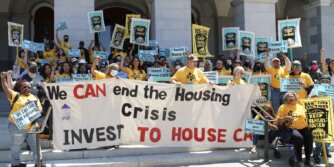The 2018 and 2019 Elections Heralded Progress on the Diversity of Local Elected Officials, but Many Bay Area Counties and Cities Still Lag Behind
For Immediate Release: February 27, 2020
Contact: Alexis Stephens, PolicyLink
alexis@policylink.org
(212) 502-6496
Today, the Bay Area Equity Atlas (BAEA) in partnership with Bay Rising released a comprehensive analysis of the race and gender makeup of top county and city elected officials in the nine-county Bay Area region. According to the Atlas’s Diversity of Electeds data, the majority of counties and cities in the Bay Area do not reflect the diversity of the communities they represent. While recent elections have ushered in new leaders, people of color—who comprise a majority in the Bay Area region—are severely
underrepresented. This lack of representation undermines equity, democracy, and belonging in the region since electeds from underrepresented communities bring crucial experience and wisdom to
policymaking and governance.
Key findings from the BAEA analysis include:
- While the region is 60% people of color, they only hold 29% of elected offices.
- There are dozens of cities without any Black, Latinx or Asian and Pacific Islander (API) representatives at all: among the 101 municipalities within the Bay Area region, 80 have zeroBlack elected offici als, 42 have zero Latinx or API elected officials, and 33 have all White elected officials.
- The share of women holding office in top municipal and county level positions is now 44% – up from 40% in May 2018; however among Latinx electeds only 40% are women.
- APIs and Latinos continue to be sorely underrepresented among local electeds, especially at the county level. Latinx and APIs make up half of the region’s population but are just 13% of top county-level elected officials. Most strikingly, Santa Clara County has the largest share of API residents of all the nine counties that make up the Bay Area (35% of residents are API), but there are no API electeds in top county positions. Similarly, in Sonoma County, which is 26% Latinx, there are no Latinx in top county elected positions.
- The most substantial changes in representation since the 2018 elections were made at the city level, including several shifts in the rankings of the cities with the largest White overrepresentation and Latinx, API, and Black underrepresentation. Five cities that were formerly represented by all-White city councils elected at least one person of color in 2018: Benicia, Brisbane, Cloverdale, San Ramon, and Santa Clara.
“While race and gender alone do not determine whether an elected official will support more just policies, representation matters for political power. Despite some progress, more work needs to be done to ensure equitable representation in local government in one of the nation’s most diverse regions,” said Ángel Ross of PolicyLink, one of the partner organizations behind the Bay Area Equity Atlas. “The Bay Area may have a reputation for being a flagbearer for the progressive movement, but the data shows that our region still lags behind on the diversity of its elected officials. To build a more equitable region, we need to ensure people of color can run for and win elected office.”
“It’s taking long-term organizing to show our communities that elections can shift the power back to them,” said Kimi Lee, director of Bay Rising. “We’re doing this by training and having face-to-face conversations with hundreds of thousands of working-class people and people of color across the Bay Area, while passing local policies that level the playing field for regular people in politics.”
“We’ve seen a flood of corporate money in Bay Area elections over the past ten years. In San Francisco alone, corporate donors representing the interests of real estate and tech companies have spent millions of dollars on local elections, making it harder for grassroots candidates of color to run strong campaigns,” said Emily Lee, director of San Francisco Rising. “We still need stronger public finance to support regular people to run for office without having to bend over backwards for large donors.”
The report shares several recommendations for how the Bay Area can make progress on political representation, including:
- Local city and county governments should pass structural reforms including stronger public campaign financing and campaign finance reform to limit corporate contributions, secret Super PACs, and “pay to play” politics, and consider shifting from at-large to district-based elections;
- Local and national philanthropies and corporations should fund equity-oriented leadership development programs that prepare people from underrepresented communities of color to effectively engage in public policy;
- Funders, political leaders, and donors should invest in training and support systems for candidates from underrepresented communities to run electoral campaigns as well as community-based programs that support new elected officials from underrepresented communities once they are in office;
- Policymakers and funders should support voting reforms and civic engagement efforts that increase voter registration and turnout among underrepresented communities, especially in local elections.
- To view the full complete analysis from the Bay Area Equity Atlas: <LINK>. For interviews with experts
- from PolicyLink, Bay Rising, and the San Francisco Foundation, please contact Alexis Stephens at
- astephens@policylink.org.
To view the full complete analysis from the Bay Area Equity Atlas: <LINK>. For interviews with experts from PolicyLink, Bay Rising, and the San Francisco Foundation, please contact Alexis Stephens atastephens@policylink.org.
###
The Bay Area Equity Atlas is a comprehensive data support system to track the state of equity across the region and equip community leaders with data to inform solutions for inclusive prosperity. The Atlas is produced by the San Francisco Foundation, PolicyLink, and the USC Program for Environmental and Regional Equity (PERE).
Bay Rising is the only regional civic engagement organization that organizes with working-class people and people of color as voters in the Bay Area year-round. Bay Rising is the umbrella network for San Francisco Rising, Oakland Rising, and Silicon Valley Rising, and represents over thirty grassroots organizations in the Bay Area.
METHODOLOGY
To examine how well the Bay Area’s top elected officials represent the diversity of the region’s population, the Bay Area Equity Atlas team assembled a unique dataset on the race/ethnicity and gender of the mayors and councilmembers of the region’s 101 municipalities and the county supervisors and district attorneys for the region’s nine counties. Our dataset captures the composition of elected officials at three points in time to include the results of the November 2017, 2018, and 2019 elections. Using the May 2018 list of elected officials provided by GovBuddy, we identified the race and gender of the elected officials via web-based research. We then sent the information to the elected officials via email and mail, providing them with multiple opportunities to correct the data. We updated this list using a July 2019 GovBuddy list and elected officials after the November 2019 elections were identified based on the last month and year of the elected position’s term. This methodology enables the collection of broad
racial/ethnic and gender categories, but not detailed ones (e.g. specific Asian or Pacific Islander subgroups, non-binary gender identification). See our full methodology here.




